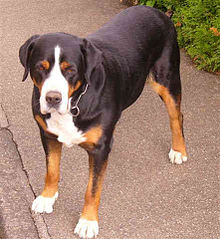Greater Swiss Mountain Dog: Difference between revisions
No edit summary |
rv broken edit |
||
| Line 14: | Line 14: | ||
| fcisection = 3 |
| fcisection = 3 |
||
| fcistd = http://www.google.com/search?q=cache:QAYDnUhgID4J:www.fci.be/uploaded_files/058A2002_en.doc+site:www.fci.be+%2258+/+05.+05.+2003%22&hl=en |
| fcistd = http://www.google.com/search?q=cache:QAYDnUhgID4J:www.fci.be/uploaded_files/058A2002_en.doc+site:www.fci.be+%2258+/+05.+05.+2003%22&hl=en |
||
| image = Großer Schweizer Sennenhund.jpg |
|||
[[immagine = GRANBOVARO.jpg]] |
|||
| image_caption = Greater Swiss Mountain Dog |
| image_caption = Greater Swiss Mountain Dog |
||
| name = Greater Swiss Mountain Dog |
| name = Greater Swiss Mountain Dog |
||
Revision as of 15:21, 26 October 2006
| Greater Swiss Mountain Dog | |||||||||
|---|---|---|---|---|---|---|---|---|---|
 Greater Swiss Mountain Dog | |||||||||
| Other names | Großer Schweizer Sennenhund Large Swiss Mountain Dog | ||||||||
| Common nicknames | Swissie GSMD | ||||||||
| Origin | Switzerland | ||||||||
| |||||||||
| Dog (domestic dog) | |||||||||
The Greater Swiss Mountain Dog, or Großer Schweizer Sennenhund, is the largest of the traditional Swiss herding breeds, the Sennenhunds, a grouping in which the Bernese Mountain Dog is also included. They are believed descended from large dogs brought to Switzerland by the Romans in the first century B.C., although another theory states that they arrived many centuries earlier with Phoenician traders. In any case, they are almost certainly the result of the mating of indigenous dogs with large mastiff-type dogs brought to Switzerland by foreign settlers. Greater Swiss Mountain Dogs are believed to be in the ancestry of both the Saint Bernard Dog and the Rottweiler.
Appearance
The Greater Swiss Mountain Dog is a large, muscular, tricolour (black, rust, and white; typically with a white blaze) dog. Males should weigh around 110 - 140 pounds the height is 25.5 - 28.5 inches at the shoulders. The females weigh 85 - 115 pounds and are 23.5 - 27 inches tall at the shoulders. The length to height ratio is around 10 to 9. This breed must have a double coat to be considered show quality. There is black on top of the dog's back, ears, tail and the majority of the legs. There should be rust on the cheeks, a thumb print above the eyes and also rust should appear on the legs between the white and black. There should be white on the muzzle, the feet, the tip of the tail, on the chest down and some that comes up from the muzzle to pass between the eyes. The fur is a double coat, the top coat being around two 2 inches long, the bottom coat being thick and a type of gray which must be on the neck, but can be all over the body.
Temperament
The Greater Swiss Mountain Dog has a reputation of combining protectiveness with a gentle nature, particularly with respect to its love of its family, especially children.
These dogs are strong, active, and remarkably agile for their size. A Swissy can be trained for weight-pulling competitions and/or to pull carts behind them carrying goods or even a person. Prospective owners need to be prepared to give them lots of time and attention. Owners will often note that, despite their large stature, they will often behave as if they are a lap dog.
History
The Greater Swiss Mountain Dog, a dog of great strength, was originally a herding dog, but was later used for draft. It may have been the advent of mechanized vehicles, combined with the rise in popularity of the Saint Bernard Dog (the Greater Swiss Mountain Dog Helped produce the Saint Bernard Dog), that led to the decline in popularity of the GSMD. However it happened, the breed was believed to be extinct, or nearly so, by the turn of the 20th Century.
In 1908, an owner named Franz Schertenlieb entered his mountain dogs in the Swiss Kennel Club (SKG) jubilee conformation dog show, knowing that they would be seen by an expert in native Swiss dogs, Dr. Albert Heim. Dr. Heim, an avid fancier, was apparently delighted to find a living example of the Großer Schweizer Sennenhund, and exhorted the members of the Kennel Club to do all that they could to safeguard the breed, including scour farms and villages for healthy specimens for a breeding program.
His suggestion was acted upon, and a careful breeding program was begun. Due to the meticulous nature of the selection process, the lack of worthy brood bitches, and the requirement that all puppies be reexamined as adults for conformation and temperament before being certified as suitable for breeding, breed numbers grew slowly.
All-breed club recognition
The Greater Swiss Mountain Dog, now often known as the GSMD or ‘Swissy’, is an example of an ancient, well-documented and established pure breed that was nevertheless not recognized by large all-breed kennel clubs around the world. The first GSMDs were introduced to the United States in 1968, and were recognized provisionally by the AKC in 1985 and received full recognition in 1995, an ironically late date for such an old breed of dog. It was recognized by the UKC in 1992.
